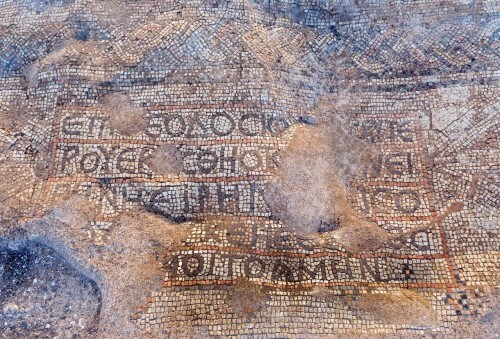In the excavations of the Antiquities Authority and youth before the establishment of new neighborhoods in the city, at the initiative of the Ministry of Construction and Housing and Rosh Ha'Ein Municipality

Impressive archeological findings are being revealed these days in extensive archeological excavations conducted by the Antiquities Authority in Rosh Ha'Ein, prior to the establishment of new neighborhoods, at the initiative of the Ministry of Construction and Housing and the Rosh Ha'Ein Municipality. Many dozens of youths from preparatory schools and youth villages participated in the excavations, as part of the Antiquities Authority's policy of bringing the public closer to its cultural heritage.
During the excavations, an impressive 2700-year-old farmhouse, measuring 50x30 m, and a 1500-year-old church with colorful mosaics and inscriptions were uncovered.
According to Amit Shadman, the director of the excavation on behalf of the Antiquities Authority, "the large farmhouse has been preserved to a height of 2 m or more." The 2700-year-old building consisted of 24 rooms, built around a central courtyard. A large storage cell (silo) was uncovered in the yard, which was designed to keep grain. It seems that carbohydrates were just as popular then as they are today, and the grain branch was very common in the rural-agricultural system in the region. We find confirmation of this in the field, in the form of many millstones, which ground grains into flour. In addition, we discovered simple textile houses carved into the rock, which were used to produce olive oil." Among other things, two silver coins from the 4th century BCE were discovered in the remains of the farm building, which bear the image of the goddess Athena and the image of the nocturnal bird of prey.
According to Shedman, this farm and similar ones operated for centuries, until the area was abandoned during the Hellenistic period. Hundreds of years later, during the 5th century AD, another settlement wave hit the area which changed the face of the landscape. Christianity, whose spread accelerated during this period, was evident, among other things, in impressive rural churches and monasteries.
On one of the hills in the area, a monastery from the Byzantine period was uncovered, which included a church, a textile house, living rooms, a stable that includes mangers and a trough, and more. The floors of the church in the monastery are made of colorful mosaics that include geometric and other patterns, as well as an inscription in Greek attributed to the priest Theodosius (a common name at the time) - "Under Theodosius the priest this place was built. Peace to you in your coming, peace to you in your departure, Amen."
Hundreds of years after the monastery finished operating, during the Ottoman period, a lime kiln operated on the site which destroyed large parts of the monastery.
In light of the impressive finds that were uncovered in the excavations, it was decided that the ancient remains will be kept in place, and they will be displayed in the public areas open to the public
